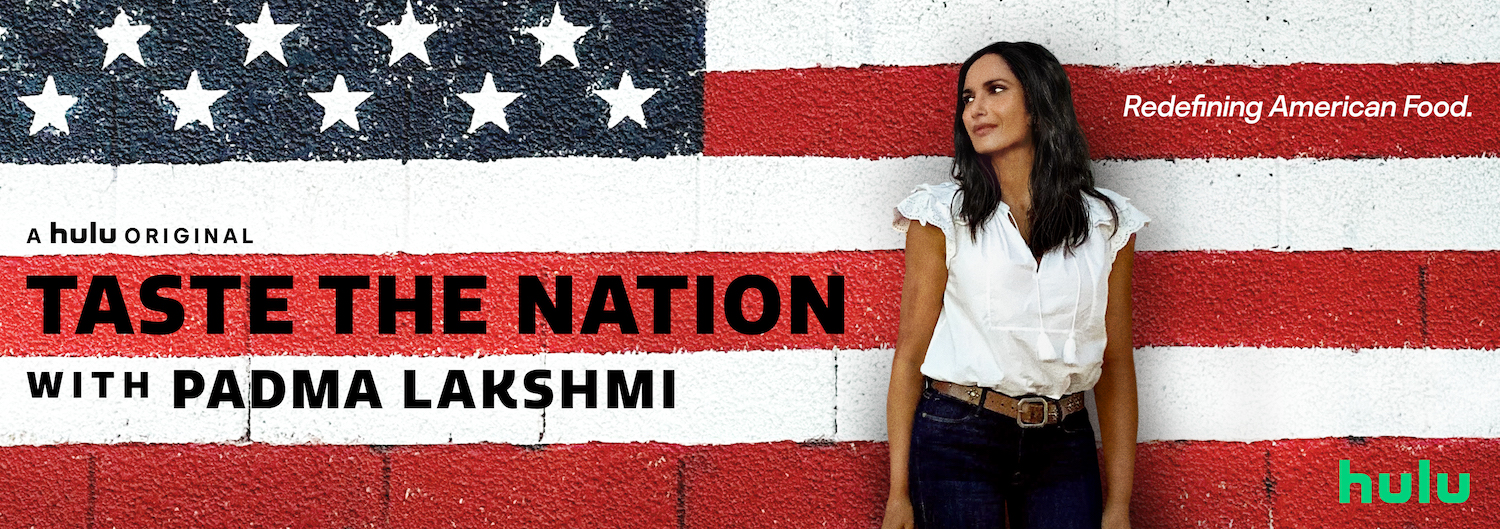Click PLAY to watch full interview
In Taste the Nation, award winning cookbook author, host (Top Chef) and executive producer Padma Lakshmi, takes audiences on a journey across America, exploring the rich and diverse food culture of various immigrant groups, seeking out the people who have so heavily shaped what American food is today. From indigenous communities to recent immigrant arrivals, Padma breaks bread with Americans across the nation to uncover the roots and relationship between our food, our humanity and our history – ultimately revealing stories that challenge notions of identity, belonging, and what it means to be American.
We sat down with Padma to talk about her latest food adventures…
The show is certainly timely as each episode appreciates all of the immigrant cultures that make up America, how and when did the idea come about for Taste the Nation?
Honestly, I’ve been working on the show for two years. It started out as a cookbook. I was looking for what I wanted to do my next book on. I was getting knee deep in work with the ACLU (American Civil Liberties Union) and immigration issues. I started getting involved after the muslim ban and then because of family separation at the border. When I made speeches for them or went to their rallies, I would always self refer to my own immigrant issue. I came here from India with my mom when I was four from India. Obviously, it’s very personal to me. After a while, looking at case studies with lawyers, I really wanted other immigrants to tell their story themselves. There was a lot of negativity and a lot of vilification of immigrants coming out of Washington for political gain and it offended me. I wanted immigrants to speak for themselves because I knew they were capable of it; and they were going to be the most compelling voice and face of this issue. Because people are used to me speaking in the language of food on TV, I decided to combine the cookbook idea with an immigrant show idea that I was already working on with my producing partner. My partner, David Smith of Part2 Pictures; he was the one who said “This is our show, let’s combine the two.” I’m really proud of the show. I could’ve never imagined the climate it would come out in; I don’t think any of us could’ve predicted this. It’s something, like Black Lives Matter, that has been going on for a long time. I wish I could say I could blame this administration for it, but I can’t because it’s not all their fault. Immigration is what built this company and certainly what shaped American food over the ages; whether it’s German immigrants or Mexican Immigrants, or forced migration of African enslaved people. I thought it was a really rich terrain to explore. I learned so much this summer from filming this.
The educational aspect of the show is great. You touch on history, teaching people about the border everything from the history of El Paso and the frontiera to Oscar Meyer Weiner. How did you choose the topics for the season?
It was hard. We had a list of 16 or 20 communities that we wanted to go to, but we wanted to differentiate ourselves from doing a survey show. There are a lot of travel/food shows around; they usually go to a city and talk about what’s cool and great or hip about that city. I wanted our show to be different; I needed it to be different. And also, I wanted to make a show I wanted to really watch. For instance, there are probably more Thai people in Los Angeles than there are in Las Vegas, but that choice to go to Vegas was very purposeful because there’s this whole enclave of Thai immigrants that came here in the 70s because of the Vietnam war and they’re predominently female. When you watch the Thai episode, it’s completely female-forward and that was purposeful. I also wanted to show the experience of these war brides, how they came here and how they were so warmly welcomed with open arms because of their in-laws. One woman lived with her in-laws for two years because she married a G.I. who was so young. She was much older than him and she had four kids. Her mother-in-law really took care of her and said “I don’t have any daughters. You are my daughter now and I know I can’t replace your mom…” And she tells that story with such grace and beauty. I wanted to show that we, as a country, have a history and tradition of being broad minded and open-hearted. Those people allowed me to tell that story in that particular theme. Then, there was the theme of misrepresentation. We went to talk to Iranians in Los Angeles. They suffered, not only because of the revolution but because of everything that happened after. Americans not knowing the difference between Persians or Iranians and Arabs; they are very different cultures, languages. The cuisine is different. We also talked to a Jewish Persian woman who’s never set foot in Iran, but is so entrenched in the culture and how she’s refound her heritage through food. We were looking at how hard it must be to be perceived as one thing, when you are not that thing and that is why you have left your country.
German, Mexican, Peruvian… you cover the gamut of food cultures in the US. As a seasoned food connoisseur, did you find yourself learning surprising facts and history you never expected to learn while shooting the show?
I learned on every episode, also because I had to do a lot of research and I was really nervous. When I’m nervous, I just try harder. Pack rat is delicious!
How about guinea pigs?!
I didn’t eat the Peruvian guinea pigs, but I saw them frozen. But I did eat Pack Rat on the San Carlos Reservation and it was delicious. It didn’t even taste gamey. I’ve had venison and that’s been much worse. This was just like a turkey leg or chicken thigh, it was great!

Out of all of the dishes, which one was your favorite?
I had a Peruvian babysitter named Elaina when I was really small in New York. I used to go to her house after school every single day until my mom came home from the hospital to pick me up on her way home from work. So, I was introduced to a lot of Peruvian foods thorugh Elaina. I didn’t remember them but going back to Little Lima was such a beautiful experience. I remember all of these different chili sauces; yellow chili, red chili. I’m talking about when I was 5, 6 and 7. Really early food memories. It all came back to me. I remembered she made really good chicken soup. Peruvian culture is really diverse; you have the tropical climate, the mountainous climate and then you have the seaside. Peruvian culture is a good way to almost explain what’s going on in America: there were a lot of Chinese there and that’s called Chifa, then the Japanese were there and they really influenced ceviche, for example and that’s why they have the Nikkei. You also have the Italians…
With the pandemic, many restaurants and some we see in the show have suffered from the national shut-down. What is. your advice as Chefs and restaurant owners open back up?
I’m not a restaurateur, nor am I a Chef. I’m a food writer, so I don’t want to start doling out advice I know nothing about. But, I do think that we will have to reinvent the industry. Real estate will be expensive, the margins for most Chefs in restaurantd was really low anyway. A lot of restaurants have already closed. So, for them to reopen, it’s going to have to be really safe. It’s not worth it to reopen and have to close a second time. If you look at the numbers, they’re shooting up again in states that reopened. In a way, that’s terrible because we’re washing away all of the hard discipline we’ve had for the last three months. But I do think there will be room for a different kind of restaurant. It will probably be like an Italian Gastronomia model where it’s prepared foods and there are a few tables there but you can pick it up. I think a lot of people will find ways to make money making food, but it will look different. Some big restaurants will come back because they have financial backing, but I think it will be a long time and our new normal is not fully formed yet.
Do you have a restaurant you recommend in Los Angeles?
Yes! It’s on Westwood Boulevard and it’s called Sham Shiri. They’re still doing takeout so please call them! Get the Fesenjan (Sweet-n-tart stew, prepared with grated walnuts, pomegranate juiceand pomegranate molasses. Served with your choice of chicken, lamb shank) and get the Kabob.
Check out: https://www.shamshiri.com/













